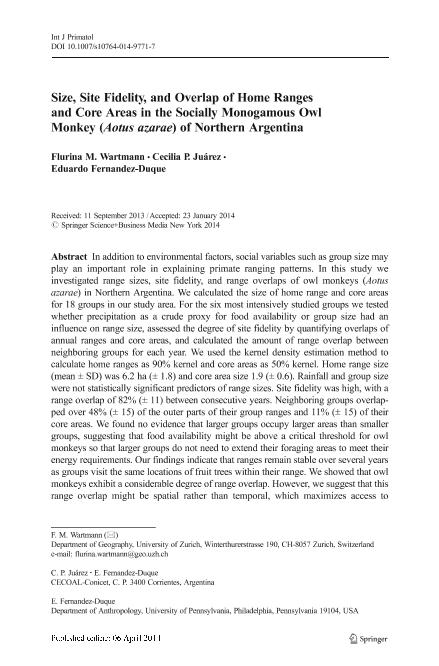Mostrar el registro sencillo del ítem
dc.contributor.author
Wartmann, Flurina M.

dc.contributor.author
Juárez, Cecilia Paola

dc.contributor.author
Fernandez Duque, Eduardo

dc.date.available
2017-10-02T14:00:50Z
dc.date.issued
2014-04
dc.identifier.citation
Wartmann, Flurina M.; Juárez, Cecilia Paola; Fernandez Duque, Eduardo; Size, site fidelity, and overlap of home ranges and core areas in the socially monogamous owl monkey (aotus azarae) of northern Argentina; Springer/plenum Publishers; International Journal of Primatology; 35; 5; 4-2014; 919-939
dc.identifier.issn
0164-0291
dc.identifier.uri
http://hdl.handle.net/11336/25541
dc.description.abstract
In addition to environmental factors, social variables such as group size may play an important role in explaining primate ranging patterns. In this study we investigated range sizes, site fidelity, and range overlaps of owl monkeys (Aotus azarae) in Northern Argentina. We calculated the size of home range and core areas for 18 groups in our study area. For the six most intensively studied groups we tested whether precipitation as a crude proxy for food availability or group size had an influence on range size, assessed the degree of site fidelity by quantifying overlaps of annual ranges and core areas, and calculated the amount of range overlap between neighboring groups for each year. We used the kernel density estimation method to calculate home ranges as 90% kernel and core areas as 50% kernel. Home range size (mean ± SD) was 6.2 ha (± 1.8) and core area size 1.9 (± 0.6). Rainfall and group size were not statistically significant predictors of range sizes. Site fidelity was high, with a range overlap of 82% (± 11) between consecutive years. Neighboring groups overlapped over 48% (± 15) of the outer parts of their group ranges and 11% (± 15) of their core areas. We found no evidence that larger groups occupy larger areas than smaller groups, suggesting that food availability might be above a critical threshold for owl monkeys so that larger groups do not need to extend their foraging areas to meet their energy requirements. Our findings indicate that ranges remain stable over several years as groups visit the same locations of fruit trees within their range. We showed that owl monkeys exhibit a considerable degree of range overlap. However, we suggest that this range overlap might be spatial rather than temporal, which maximizes access to clumped feeding resources in overlapping areas that are used at distinct times, while excluding other males from access to females in exclusively used areas.
dc.format
application/pdf
dc.language.iso
eng
dc.publisher
Springer/plenum Publishers

dc.rights
info:eu-repo/semantics/openAccess
dc.rights.uri
https://creativecommons.org/licenses/by-nc-sa/2.5/ar/
dc.subject
Core Area
dc.subject
Home Range
dc.subject
Aotus Azarae
dc.subject
Kernel Density Estimation
dc.subject
Site Fidelity
dc.subject
Social Monogamy
dc.subject
Territoriality
dc.subject.classification
Bioquímica y Biología Molecular

dc.subject.classification
Ciencias Biológicas

dc.subject.classification
CIENCIAS NATURALES Y EXACTAS

dc.title
Size, site fidelity, and overlap of home ranges and core areas in the socially monogamous owl monkey (aotus azarae) of northern Argentina
dc.type
info:eu-repo/semantics/article
dc.type
info:ar-repo/semantics/artículo
dc.type
info:eu-repo/semantics/publishedVersion
dc.date.updated
2017-09-19T18:23:29Z
dc.identifier.eissn
1573-8604
dc.journal.volume
35
dc.journal.number
5
dc.journal.pagination
919-939
dc.journal.pais
Estados Unidos

dc.journal.ciudad
New York
dc.description.fil
Fil: Wartmann, Flurina M.. University Of Zurich; Suiza
dc.description.fil
Fil: Juárez, Cecilia Paola. Consejo Nacional de Investigaciones Científicas y Técnicas. Centro Científico Tecnológico Conicet - Nordeste. Centro de Ecología Aplicada del Litoral. Universidad Nacional del Nordeste. Centro de Ecología Aplicada del Litoral; Argentina
dc.description.fil
Fil: Fernandez Duque, Eduardo. Consejo Nacional de Investigaciones Científicas y Técnicas. Centro Científico Tecnológico Conicet - Nordeste. Centro de Ecología Aplicada del Litoral. Universidad Nacional del Nordeste. Centro de Ecología Aplicada del Litoral; Argentina
dc.journal.title
International Journal of Primatology

dc.relation.alternativeid
info:eu-repo/semantics/altIdentifier/url/https://link.springer.com/article/10.1007/s10764-014-9771-7
dc.relation.alternativeid
info:eu-repo/semantics/altIdentifier/doi/http://dx.doi.org/10.1007/s10764-014-9771-7
Archivos asociados
